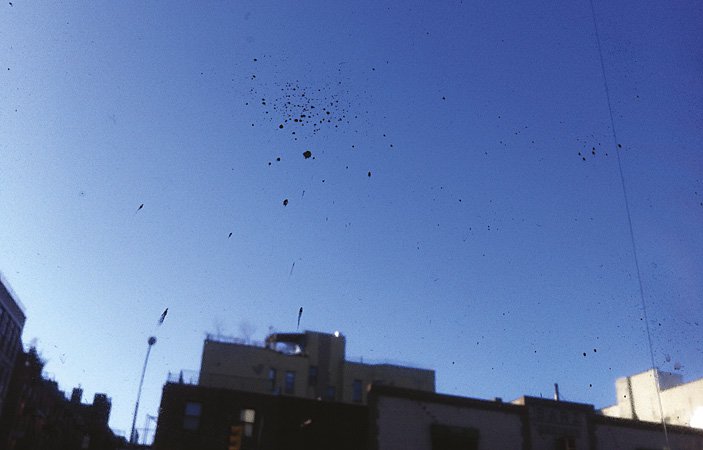Cultural Center of the Philippines
ENCYCLOPEDIA OF
PHILIPPINE ART
Balloon
2012 / Silver, gelatin on glass installation / Artist: Gary-Ross Pastrana
Balloon was installed as a very subtly discursive piece mounted on the front window of the New Museum in New York. Pastrana slathered gelatin on the glass and blew silver dust upon it, creating granular indications on the reflective surface. The artwork was readily visible to viewers peering at the museum from the outside, but was easily missed by visitors viewing it from the museum’s interior. Despite its unobtrusiveness, Balloon was read by the museum and Western art press as art coming out of a bold generation of artists born at the tail end of liberation and independence movements of the 1960s and 1970s. Institutionally categorized as “provisional, site-specific, and performative, reflecting an attitude of possibility and resourcefulness,” the works in the exhibition The Ungovernables, the second of the New Museum’s generational biennales, also demonstrated how some artists remain disinclined toward dishing up the didactic. Tellingly enough, The Ungovernables’ tag was lifted from a moniker disparagingly used for the African National Congress at the height of resistance against apartheid. Thus, the exhibition as a whole was persistently read as political, even as artists and theorists continued to tangle with the meanings of the terms political, radical, and social.
Possibly inspired by the painter’s mentor Roberto Chabet’s interest in the intractability of process and reference in art creation, Balloon showcases Pastrana’s predilection for understated transformations of everyday objects. In the work, the gesture of clouding over the apparent clarity of the glass window prompts a reconsideration of how marking materials like silver and gelatin used in photography fail to register. The work could also be seen in light of how photography has become so ubiquitous, given the accessibility of point-and-shoot technology to anyone who aspires to be an artist. Perhaps too in the context of a museum show, the materials employed by Pastrana may be seen as alluding to the illusory notion of the precious in the art world. It also exemplifies the quality of being averse to “incorporation and monetization,” which the curator Eunjie Joo assembled for this exhibition. In Pastrana’s case, the fleeting and intractable mode also informs Pastrana’s various temporal engagements, like the defunct art spaces Future Prospects and Theo Gallery, and his teaming up with the design collective Broke. Pastrana comes from a generation of artist-organizers who rode the crest of the 1990s wave of artist-run spaces, which short-circuited the art circulation and validation channels. Taken in this specific context, Balloon may open up to readings that take the balloon as a stand-in for a bubble, as in the art market bubble, or merely as the unwieldy, fraught membrane that desperately shields the artist’s interiority from forces that may challenge individuality and independence.
Written by Maria Eileen Legaspi-Ramirez
Sources
Art Radar. 2014. “Artist Gary Ross Pastrana Redefining the Notions of What Is Filipino.” 23 May. http://artradarjournal.com/2014/05/23/artist-gary-ross-pastrana-redefining-thenotions-of-what-is-filipino-interview/.
Duray, Dan. 2011. “Check Out the New Museums Ungovernables.” http://observer.com/2011/12/check-out-the-new-museumsungovernables/.
New Museum. 2012. “‘The Ungovernables’ Artists Roundtable.” http://archive.newmuseum.org/index.php/Detail/Occurrence/Show/occurrence_id/1453.
Shultz, Charles. 2012. https://nakedartcriticism.files.wordpress.com/2012/04/gary-ross-pastrana1.jpg.
